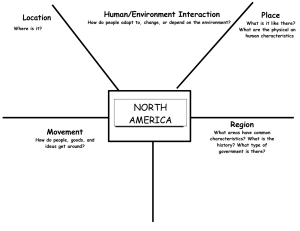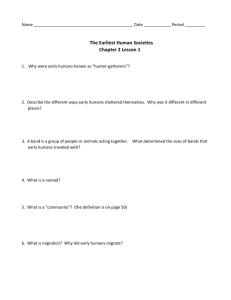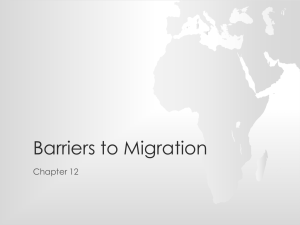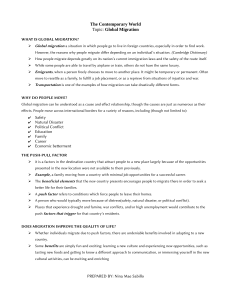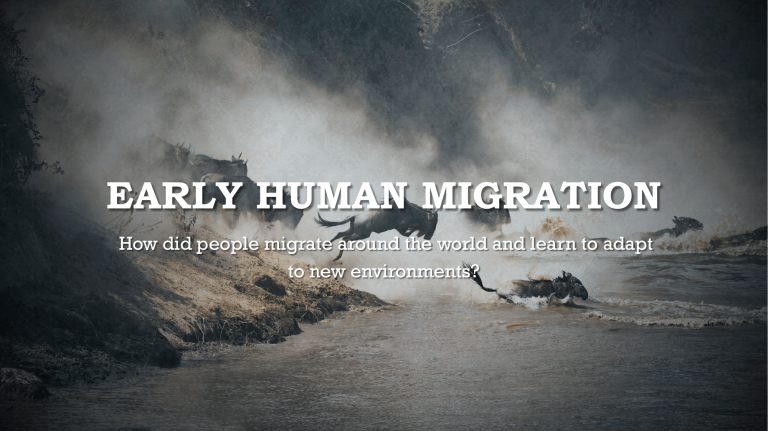
EARLY HUMAN MIGRATION How did people migrate around the world and learn to adapt to new environments? LEARNING OBJECTIVE: • We are going to learn how humans were able to migrate around the world prehistorically , so we will be able to analyze why people choose to migrate from one place to another from past to present. HW: PLEASE DEFINE THE FOLLOWING TERMS AND ANSWER THE QUESTION LISTED BELOW (75 WORDS OR LESS) How and why did humanity spread across the earth? Early Hominids Migrate Land Bridges Ice age Biomes Locations of Earliest Human Remains • Where are the earliest human remains located? • What continent? • What region? Answer: Sub-Saharan Africa 1. 2. 3. 4. Find the locations of the earliest human remains on the map below. Draw arrows where you think humans would move. If that is not possible, come up and show me where you think they moved next,,, How long do you think it took humans to move from Africa to Asia, Asia to North America, Africa to Europe? Biomes Map Which biome was where the earliest human remains were found? What challenges to survival exist in that biome? How would humans need to adapt if they moved to a different biome? A biome is a major ecological community that corresponds to a climate and is characterized by the plants that live in that environment. OUT OF AFRICA • migrate – move • During the Old Stone Age climate patterns around the world changed, transforming the earth’s geography • In response to these changes people migrated to different areas How did people migrate around the world and learn to adapt to new environments? ICE AGES • about 1.6 million years ago, many places around the world began to experience long periods of freezing weather. • These freezing times are called the ice ages. • The ice ages ended about 10,000 years ago. How did people migrate around the world and learn to adapt to new environments? LAND BRIDGES • During the ice ages, people believe the ocean levels dropped, leaving a land bridge between Asia and North America • Land bridge – a strip of land connecting two continents • Land bridges allowed people of the old stone age to migrate around the world How did people migrate around the world and learn to adapt to new environments? SETTLING NEW LANDS • Early hominids migrated from Africa to Asia as early as 2 million years ago. • From there, they spread to Southeast Asia and Europe. • Later, humans also began to migrate around the world, and earlier hominids died out. How did people migrate around the world and learn to adapt to new environments? SETTLING NEW LANDS • Humans began to migrate from East Africa to southern Africa and southwestern Asia around 100,000 years ago. • From there, people moved east across southern Asia. They could then migrate to Australia. • From southwestern Asia, humans also migrated north into Europe. • Geographic features such as high mountains and cold temperatures delayed migration northward into northern Asia. Eventually, however, people from both Europe and southern Asia moved into that region. How did people migrate around the world and learn to adapt to new environments? SETTLING NEW LANDS • From northern Asia, people moved into North America. Once in North America, these people moved south, following herds of animals and settling South America. • By 9000 B.C.E, humans lived on all continents of the world except Antarctica. How did people migrate around the world and learn to adapt to new environments? MIGRATION FLOW CHART Europe E. Asia S. America Australia How did people migrate around the world and learn to adapt to new environments? PEOPLE ADAPT TO NEW ENVIRONMENTS • As people moved, they found environments that differed greatly from those in East Africa • Many places were much colder and had strange plants and animals. • Early people had to learn to adapt to their new environments. EQ: How did people migrate around the world and learn to adapt to new environments? Please consider answers bell-ringer and I would like for you to compare and contrast with migration Push vs. Pull Factors • • Push factors: Negative reasons for wanting to leave a place (emigrate). Examples of push factors are a lack of food or water, natural disasters, a lack of jobs, and wars. Pull factors: Positive reasons for wanting to move to a place (immigrate). Examples of pull factors are more food and water, a better climate, higher wages, and freedom. Source: “What is Human Migration?” 2005. National Geographic Society. Available online at: http://www.nationalgeographic.com/xpeditions/lessons/09/g68/migrationguidestudent.pdf Using DNA samples, fossils and ancient artifacts, scientists have come to believe that modern humans originated in Africa around 200,000 years ago. Humans remained in Africa (and only in Africa) for thousands of years. Sometime between 80,000 and 60,000 years ago, humans began to migrate out of Africa, first to Asia and later to Indonesia, Papua New Guinea, and Australia. The Great Human Migration had begun. By 40,000 years ago, humans migrated to Europe, probably by two different routes. Around 15,000 years ago, humans migrated to North America from Asia, and finally to South America. Most of this migration occurred slowly and gradually and occurred over long periods. Because this happened so long ago and there are no written records, we do not know exactly why humans migrated out of Africa or why they kept migrating until they had settled throughout the world. However, we do have evidence that gives us some clues about these prehistoric times: We know that early human migrants were hunter-gatherers. We also know that climatic changes occurred. We know that human language and communication developed, as did technology, enabling the production of better tools. Many other reasons may also have led to early migrations. The reasons for migrating are often described in terms of push factors (negative reasons for wanting to leave a place) and pull factors (positive reasons for wanting to go to a place). When making any voluntary decision, people consider the benefits and costs, or the advantages and disadvantages of doing something or not doing it. If the benefits of migrating are greater than the costs, the decision will be to migrate. If the costs of migrating are greater than the benefits, the decision will be not to migrate. What are some geographic challenges or environmental obstacles that might prevent the movement of people to certain areas?
